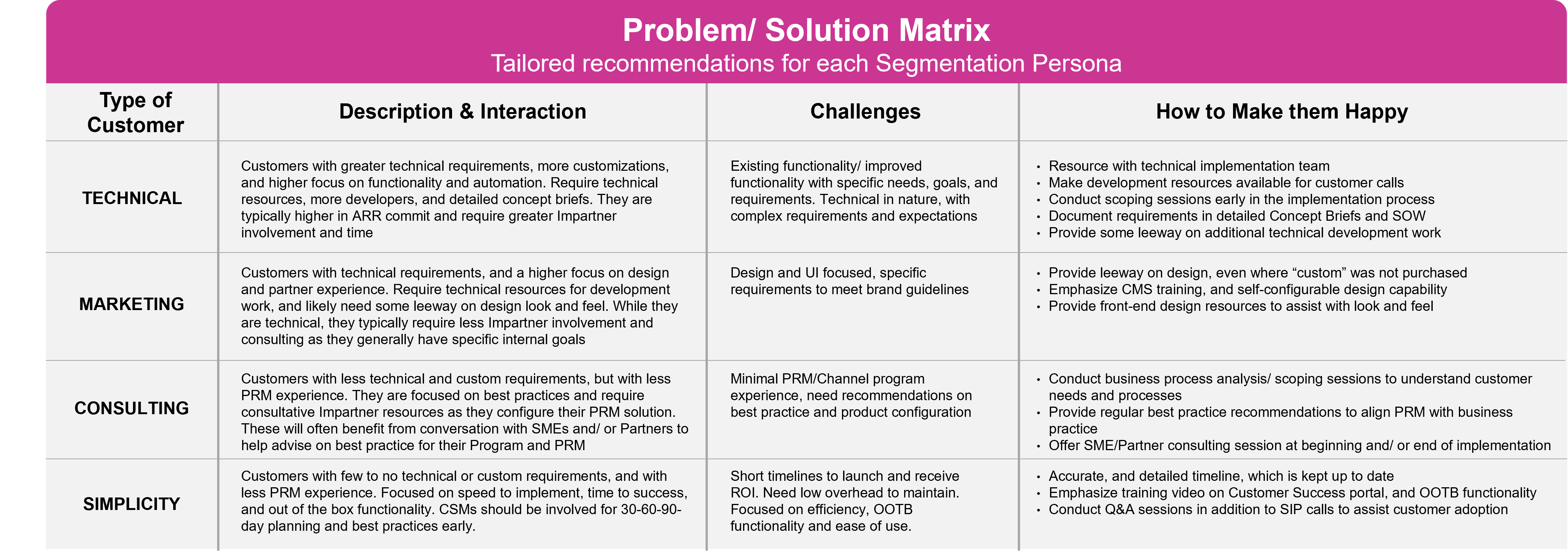Most conversations around personas happen with the marketing or product teams. These groups use personas to define typical customers by their demographics, likes, values, backgrounds, goals, challenges, aspirations, etc. A persona profile includes a picture and some statements representing the person.
It might include where to reach that person, especially for marketing purposes. The product team might use it for successful product design so that a product is sticky, has higher performance and has fewer technical issues.
Using persona-based services in implementation, customer support and customer success lay an essential foundation for startups and early-stage companies. We did, and it has transformed our company.
It began with an internal commitment to become a 100% customer-centered organization. We knew we could improve the customer experience, which was good, but not the level we strive for. We satisfied customers, but we also weren’t making them ecstatic. We looked at every process, deliverable, product and customer engagement through the lens of the customer and committed to a method of constant reinvention to improve the customer experience.
So, we dove into the numbers.
Personas persist throughout the entire customer lifecycle. From sales to implementation to support, customer success and renewal.
Even though each customer implementation was different, there were some similarities and characteristics we could cross-match among multiple customer sets. We looked at 250 data points — about two-thirds were internal and the rest were from secondary research about the company and the market.
Some of the items we looked at were:
- Have they used a competitor’s software?
- What is their reason for choosing us?
- Are they transitioning from spreadsheets and files?
- What specific problems are they trying to solve? For example, one customer noted that competitors provided partner quotes in hours as opposed to their company, which took multiple days.
- What is their primary goal to achieve with our software?
We added this intelligence to the standard knowledge transfer call between the sales and implementation teams to learn as much about the customer as possible. We used all those points to categorize each customer into one of four personas. These personas work for us. Your customer data can lead you to create the personas that matter most in your customer base.
We categorized our implementations into four different personas.
-
- Simplicity — Focused on implementation speed, time to success and out-of-the-box functionality. CSMs should be involved in 30-60-90-day planning and best practices early.
- Marketing — Focused on design and partner experience. They might ask 10 questions about the picture gallery on the partner portal homepage. They will ask about specific design elements, such as if buttons can have rounded corners instead of squares, etc.
- Technical — Focused on a high-tech-influenced experience. Customers will have more significant technical requirements, more customizations and a sophisticated focus on functionality and automation. They want to know about integrations, automation, workflows, segmentation, notifications, etc. Implementations require technical resources, more developers and detailed concept briefs.
- Consulting — They want a little bit of everything. They want the implementation to be fast so they can show results quickly, and they focus a lot on best practices. They know we are the experts and want to understand how others do things compared to their processes. They are looking for benchmarking processes and how they can improve partner operations. For example, they will ask, “This is how we do deal registration. How do others do it?”

Image Credits: Impartner
- Based on those personas, we determine what specific actions will make them happy, including what resources we provide, how we communicate timing and expectations and even what kind of project manager is assigned.
We determined their implementation project manager based on bandwidth and geography. We would assign someone who has a hole in their schedule and is closest to the customer’s location — if they were an East Coast client, they would get paired with an East Coast manager.
Today, we pair project managers and timelines based on personas. When we start a new implementation, we give them the project plan for completion. We automatically include different resources in that project plan over different horizons. Personas inform our implementation leaders on how they will use our software, what outcomes should come from the implementation and even who should be on the project team. Then, we anticipate what we can do to create the project plan, so our teams can deploy the right people, processes and technology at the right time, even before the client asks for them. Surprise and delight your customers by being ready for what they need before they ask for it.
For example, if the customer is a technical person, we would automatically include their developers in the calendar invites. We would set the expectations that their technical team is needed, and they don’t even need to ask — we know they will need them. For marketing, we include the front-end designers and UI members on the implementation calls, etc.
Following these steps has led to better implementation outcomes. In 2020, our customer satisfaction scores were between 2.5 and 3.0 (on a 1-5 scale). By the end of 2021, our rolling 12-month average was 4.81. In 2022, we moved to NPS surveys taken at close, after implementation, and every six months after that. Our NPS is 71 on a rolling 90-day average.
Personas persist throughout the entire customer lifecycle. From sales to implementation to support, customer success and renewal. It is more than just segmenting a customer type; it is a customer DNA marker. It opens the door to innovation in the customer experience. Instead of just asking, “What would improve the customer experience?”, it allows our teams to brainstorm about value-added services that serve a particular persona. We then predict and meet the customer need before they even realize the need.
Other industries have used this approach successfully for decades. Consider the disparity between the customer personas that would buy a Ford F-150, Ford Mustang or a Ford Transit. The stronger your brand, the more diverse your use cases and the greater value you will get from persona-based services.
How can you set up your personas? There is no one-size-fits-all methodology. First, understand what success looks like and understand your ecosystem. Go beyond the basics. Start with customer demographics and then look at what makes your offering unique. Why are customers using your products and solutions?
With that knowledge, you can determine what data points you want to use. You can also learn a lot from what your customers are saying. What challenges are they having? What complaints do you hear, especially those that are being repeated? One key to successful personas is focusing on where you are failing and succeeding tremendously.
Startups can use personas not only in marketing and product management but also in implementation and customer success. Then, surprise and delight the customer when you provide things they need before they ask for them. You’ll see huge improvements in your customer satisfaction and NPS scores when you do.
